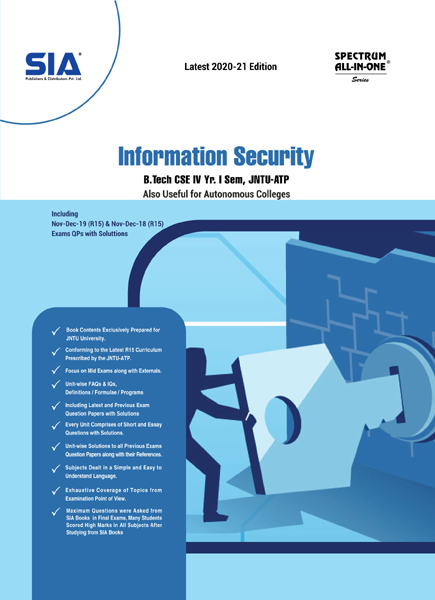

Note: Please check your Spam or Junk folder, in case you didn't receive the email with verification code.
SYLLABUS
Unit-I
Computer Security Concepts, The OSI Security Architecture, Security Attacks, Security Services and Security Mechanisms, A Model for Network Security. Classical Encryption Techniques – Symmetric Cipher Model, Substitution Ciphers, Transposition Ciphers, Steganography. Modern Block Ciphers: Block Ciphers Principles, Data Encryption Standard (DES), Strength of DES, Linear and Differential Cryptanalysis, Block Cipher Modes of Operations, AES, RC4.
Unit-II
Introduction to Number Theory – Integer Arithmetic, Modular Arithmetic, Matrices, Linear Congruence, Algebraic Structures, GF(2n ) Fields, Primes, Primality Testing, Factorization, Chinese Remainder Theorem, Quadratic Congruence, Exponentiation and Logarithm. Public-key Cartography – Principles of Public-key Cryptography, RSA Algorithm, Diffie-Hellman Key Exchange, ELGamal Cryptographic System, Elliptic Curve Arithmetic, Elliptic Curve Cryptography.
Unit-III
Cryptographic Hash Functions: Applications of Cryptographic Hash Functions, Requirements and Security, Hash Functions Based on Cipher Block Chaining, Secure Hash Algorithm (SHA). Message Authentication Codes: Message Authentication Requirements, Message Authentication Functions, Requirements for Message Authentication Codes, Security of MACs, HMAC, MACs Based on Block Ciphers, Authenticated Encryption. Digital Signatures – RSA with SHA and DSS.
Unit-IV
Key Management and Distribution: Symmetric Key Distribution Using Symmetric Encryption, Symmetric Key Distribution Using Asymmetric, Distribution of Public Keys, X.509 Certificates, Public Key Infrastructure. User Authentication: Remote User Authentication Principles, Remote User Authentication Using Symmetric Encryption, Kerberos, Remote User Authentication Using Asymmetric Encryption, Federated Identity Management, Electronic Mail Security: Pretty Good Privacy (PGP), S/MIME.
Unit-V
Security at the Transport Layer (SSL and TLS) : SSL Architecture, Four Protocols, SSL Message Formats, Transport Layer Security, HTTPS, SSH. Security at the Network Layer (IPSec): Two Modes, Two Security Protocols, Security Association, Security Policy, Internet Key Exchange. System Security: Description of the System, Users, Trust and Trusted Systems, Buffer Overflow and Malicious Software, Malicious Programs, Worms, Viruses, Intrusion Detection System (IDS), Firewalls.
 No Preview is available for this book
No Preview is available for this book

 Get 100 instant uPoints on the purchase of Rs.100 or above for each order.
Get 100 instant uPoints on the purchase of Rs.100 or above for each order.
CategoriesEngineering

Format EPUB

TypeeBook